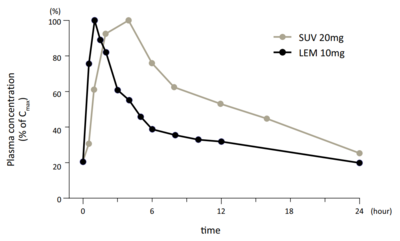Chemistry:Lemborexant
 | |
| Clinical data | |
|---|---|
| Trade names | Dayvigo |
| Other names | E-2006 |
| License data |
|
| Pregnancy category | |
| Routes of administration | By mouth[3] |
| Drug class | Orexin receptor antagonist; Hypnotic; Sedative |
| ATC code | |
| Legal status | |
| Legal status | |
| Pharmacokinetic data | |
| Bioavailability | Good (≥87%)[5][6] |
| Protein binding | 94%[3] |
| Metabolism | Liver (major: CYP3A4, minor: CYP3A5)[3] |
| Metabolites | M10[3] |
| Elimination half-life | 17–19 hours or 55 hours[3][7] |
| Excretion | Feces: 57.4%[3] Urine: 29.1%[3] |
| Identifiers | |
| |
| CAS Number | |
| PubChem CID | |
| IUPHAR/BPS | |
| DrugBank | |
| ChemSpider | |
| UNII | |
| KEGG | |
| ChEMBL | |
| Chemical and physical data | |
| Formula | C22H20F2N4O2 |
| Molar mass | 410.425 g·mol−1 |
| 3D model (JSmol) | |
| |
| |
Lemborexant, sold under the brand name Dayvigo, is an orexin antagonist medication which is used in the treatment of insomnia.[3][8] It is indicated specifically for the treatment of insomnia characterized by difficulties with sleep onset and/or maintenance in adults.[3][8] The medication is taken by mouth.[3][8]
Side effects of lemborexant include somnolence, fatigue, headache, and abnormal dreams.[3][8] The medication is a dual orexin receptor antagonist (DORA).[3][8] It acts as a selective dual antagonist of the orexin receptors OX1 and OX2.[3][8] Lemborexant has a long elimination half-life of 17 to 55 hours and a time to peak of about 1 to 3 hours.[3][8] It is not a benzodiazepine or Z-drug and does not interact with GABA receptors, instead having a distinct mechanism of action.[3][8]
Lemborexant was approved for medical use in the United States in December 2019.[9][10][11] It is a schedule IV controlled substance in the United States and may have a low potential for misuse.[3][8] Besides lemborexant, other orexin receptor antagonists including suvorexant and daridorexant have also been introduced.[12][13]
Medical uses
Lemborexant is used in the treatment of insomnia in adults.[3]
A major systematic review and network meta-analysis of medications for the treatment of insomnia published in 2022 found that lemborexant had an effect size (standardized mean difference (SMD)) against placebo for treatment of insomnia at 4 weeks of 0.36 (95% CI 0.08 to 0.63) and at 3 months of 0.41 (95% CI 0.04 to 0.78).[14] Lemborexant had similar effect sizes at 4 weeks as the other evaluated and marketed orexin receptor antagonists suvorexant (SMD 0.31, 95% CI 0.01 to 0.62) and daridorexant (SMD 0.23, 95% CI –0.01 to 0.48), whereas benzodiazepines and Z-drugs generally showed larger effect sizes (e.g., SMDs of 0.45 to 0.83) than lemborexant and the other orexin receptor antagonists.[14] However, the review concluded that lemborexant and eszopiclone among all of the insomnia medications assessed had the best profiles overall in terms of efficacy, tolerability, and acceptability.[14]
Compared to benzodiazepines, there is a low risk of developing tolerance and dependence.[15] Memory and attention are not affected the next morning when taking lemborexant.[16]
Available forms
Lemborexant is available in the form of 5 and 10 mg oral film-coated tablets.[3]
Side effects
Side effects of lemborexant include somnolence or fatigue (combined preferred terms of somnolence, lethargy, fatigue, and sluggishness) (6.9% at 5 mg and 9.6% at 10 mg vs. 1.3% for placebo), headache (5.9% at 5 mg and 4.5% at 10 mg vs. 3.4% for placebo), and nightmares or abnormal dreams (0.9% at 5 mg and 2.2% at 10 mg vs. 0.9% for placebo).[3] Less common side effects include sleep paralysis (1.3% at 5 mg and 1.6% at 10 mg vs. 0% for placebo) and hypnagogic hallucinations (0.1% at 5 mg and 0.7% at 10 mg vs. 0% for placebo).[3]
Lemborexant at doses of 10, 20, and 30 mg produces drug-liking responses similar to those of zolpidem (30 mg) and suvorexant (40 mg) in recreational sedative drug users.[3] It is a controlled substance in the United States and is considered to have a low misuse potential.[3][17]
Pharmacology
Pharmacodynamics
Lemborexant is a dual antagonist of the orexin OX1 and OX2 receptors.[18][19][20] It associates and dissociates from the orexin receptors more rapidly than certain other orexin receptor antagonists, such as suvorexant, and this may cause it to have a shorter duration of action.[12]
Pharmacokinetics
The bioavailability of lemborexant is good and is at least 87%.[5][6] The time to peak levels of lemborexant is 1 to 3 hours.[3] A high-fat and high-calorie meal has been found to delay the time to peak levels by 2 hours.[3] Its plasma protein binding in vitro is 94%.[3] Lemborexant is metabolized primarily by CYP3A4 and to a lesser extent by CYP3A5.[3] The "effective" half-life of lemborexant is 17 to 19 hours while its terminal elimination half-life is 55 hours.[3][7][8] The medication is excreted in feces (57%) and to a lesser extent urine (29%).[3]

Although lemborexant has a longer terminal elimination half-life than suvorexant, it appears to be more rapidly cleared than suvorexant in the earlier phases of elimination.[21][7] In addition, lemborexant dissociates from the orexin receptors more rapidly than does suvorexant.[21] These differences may allow for comparatively reduced next-day effects such as daytime somnolence with lemborexant.[21][7]
History
In June 2016, Eisai initiated Phase III clinical trials in the United States, France, Germany, Italy, Japan, Poland, Spain and the UK.[22]
In December 2019, lemborexant was approved for use in the United States based on results from the SUNRISE 1 and SUNRISE 2 Phase III clinical trials.[11][23]
Society and culture
Names
Lemborexant is the generic name of the drug and its INN while E-2006 was its developmental code name. Lemborexant is sold under the brand name Dayvigo.[3]
Availability
Lemborexant is marketed in the United States, Canada , Australia , and Japan .[24][25][26][27] It is not approved by the European Medicines Agency (EMA) for use in the European Union or by the Medicines and Healthcare products Regulatory Agency (MHRA) in the United Kingdom .[28][29]
Research
Lemborexant is under development for the treatment of circadian rhythm sleep disorders, sleep apnea, and chronic obstructive pulmonary disease.[30] As of February 2022, it is in phase 2 clinical trials for circadian rhythm sleep disorders and phase 1 trials for sleep apnea and chronic obstructive pulmonary disease.[30]
References
- ↑ 1.0 1.1 "Dayvigo". 23 July 2021. https://www.tga.gov.au/apm-summary/dayvigo.
- ↑ "Updates to the Prescribing Medicines in Pregnancy database". 12 May 2022. https://www.tga.gov.au/resources/resource/guidance/updates-prescribing-medicines-pregnancy-database.
- ↑ 3.00 3.01 3.02 3.03 3.04 3.05 3.06 3.07 3.08 3.09 3.10 3.11 3.12 3.13 3.14 3.15 3.16 3.17 3.18 3.19 3.20 3.21 3.22 3.23 3.24 3.25 3.26 3.27 3.28 3.29 "Dayvigo- lemborexant tablet, film coated". https://dailymed.nlm.nih.gov/dailymed/drugInfo.cfm?setid=7074cb65-77b3-45d2-8e8d-da8dc0f70bfd.
- ↑ "Summary Basis of Decision (SBD) for Dayvigo". 23 October 2014. https://hpr-rps.hres.ca/reg-content/summary-basis-decision-detailTwo.php?linkID=SBD00529&lang=en.
- ↑ 5.0 5.1 "Lemborexant. Dual orexin receptor antagonist, Treatment of insomnia". Drugs of the Future 43 (10): 715. 2018. doi:10.1358/dof.2018.043.10.2828699. ISSN 0377-8282.
- ↑ 6.0 6.1 "Population Pharmacokinetics and Exposure-Response Analyses for the Most Frequent Adverse Events Following Treatment With Lemborexant, an Orexin Receptor Antagonist, in Subjects With Insomnia Disorder". Journal of Clinical Pharmacology 60 (12): 1642–1654. December 2020. doi:10.1002/jcph.1683. PMID 32666570.
- ↑ 7.0 7.1 7.2 7.3 "Clinical pharmacology, efficacy, and safety of orexin receptor antagonists for the treatment of insomnia disorders". Expert Opinion on Drug Metabolism & Toxicology 16 (11): 1063–1078. November 2020. doi:10.1080/17425255.2020.1817380. PMID 32901578.
- ↑ 8.00 8.01 8.02 8.03 8.04 8.05 8.06 8.07 8.08 8.09 "Review of the Efficacy and Safety of Lemborexant, a Dual Receptor Orexin Antagonist (DORA), in the Treatment of Adults With Insomnia Disorder". The Annals of Pharmacotherapy 56 (2): 213–221. February 2022. doi:10.1177/10600280211008492. PMID 34078141.
- ↑ "Novel Drug Approvals for 2019". 2 January 2020. http://www.fda.gov/drugs/new-drugs-fda-cders-new-molecular-entities-and-new-therapeutic-biological-products/novel-drug-approvals-2019.
 This article incorporates text from this source, which is in the public domain.
This article incorporates text from this source, which is in the public domain.
- ↑ "FDA-Approved Drugs: Lemborexant". https://www.accessdata.fda.gov/scripts/cder/daf/index.cfm?event=overview.process&ApplNo=212028.
- ↑ 11.0 11.1 "FDA Approves Dayvigo (lemborexant) for the Treatment of Insomnia in Adult Patients". 23 December 2019. https://www.drugs.com/newdrugs/fda-approves-dayvigo-lemborexant-insomnia-adult-patients-5132.html.
- ↑ 12.0 12.1 "Hypocretins (orexins): The ultimate translational neuropeptides". Journal of Internal Medicine 291 (5): 533–556. May 2022. doi:10.1111/joim.13406. PMID 35043499.
- ↑ "Daridorexant: First Approval". Drugs 82 (5): 601–607. April 2022. doi:10.1007/s40265-022-01699-y. PMID 35298826.
- ↑ 14.0 14.1 14.2 "Comparative effects of pharmacological interventions for the acute and long-term management of insomnia disorder in adults: a systematic review and network meta-analysis". Lancet 400 (10347): 170–184. July 2022. doi:10.1016/S0140-6736(22)00878-9. PMID 35843245.
- ↑ "The effect of lemborexant for insomnia disorder". SAGE Open Medicine 9: 20503121211039098. 18 August 2021. doi:10.1177/20503121211039098. PMID 34422270.
- ↑ "Safety of lemborexant versus placebo and zolpidem: effects on auditory awakening threshold, postural stability, and cognitive performance in healthy older participants in the middle of the night and upon morning awakening". Journal of Clinical Sleep Medicine 16 (5): 765–773. May 2020. doi:10.5664/jcsm.8294. PMID 32022664.
- ↑ "Nonclinical evaluation of abuse liability of the dual orexin receptor antagonist lemborexant". Regulatory Toxicology and Pharmacology 127: 105053. December 2021. doi:10.1016/j.yrtph.2021.105053. PMID 34619288.
- ↑ "Small-molecule antagonists of the orexin receptors". Pharmaceutical Patent Analyst 3 (6): 625–638. 2014. doi:10.4155/ppa.14.46. PMID 25489915.
- ↑ "Recent trends in orexin research--2010 to 2015". Bioorganic & Medicinal Chemistry Letters 25 (15): 2875–2887. August 2015. doi:10.1016/j.bmcl.2015.05.012. PMID 26045032.
- ↑ "Orexin receptor antagonists--a patent review (2010 to August 2014)". Expert Opinion on Therapeutic Patents 24 (12): 1367–1381. December 2014. doi:10.1517/13543776.2014.978859. PMID 25407283.
- ↑ 21.0 21.1 21.2 21.3 "Evidence-based insomnia treatment strategy using novel orexin antagonists: A review". Neuropsychopharmacology Reports 41 (4): 450–458. December 2021. doi:10.1002/npr2.12205. PMID 34553844.
- ↑ "Lemborexant". https://www.sps.nhs.uk/medicines/lemborexant/.
- ↑ "Drug Trials Snapshot: Dayvigo". 20 December 2019. http://www.fda.gov/drugs/drug-approvals-and-databases/drug-trials-snapshot-dayvigo.
 This article incorporates text from this source, which is in the public domain.
This article incorporates text from this source, which is in the public domain.
- ↑ "Micromedex Products: Please Login". https://www.micromedexsolutions.com/micromedex2/librarian/.
- ↑ "Drug Product Database: Access the database". 18 March 2010. https://www.canada.ca/en/health-canada/services/drugs-health-products/drug-products/drug-product-database.html.
- ↑ "Dayvigo". 23 July 2021. https://www.tga.gov.au/apm-summary/dayvigo.
- ↑ "EISAI TO LAUNCH IN-HOUSE DEVELOPED NEW ANTI-INSOMNIA DRUG DAYVIGO® (LEMBOREXANT) WITH INDICATION FOR INSOMNIA IN JAPAN | News Release:2020 | Eisai Co., Ltd". https://www.eisai.com/news/2020/news202036.html.
- ↑ "Medicines". European Medicines Agency. https://www.ema.europa.eu/en/medicines.
- ↑ "Products". Medicines and Healthcare products Regulatory Agency (MHRA). https://products.mhra.gov.uk/.
- ↑ 30.0 30.1 "Lemborexant - Eisai - AdisInsight". https://adisinsight.springer.com/drugs/800035210.
 |

